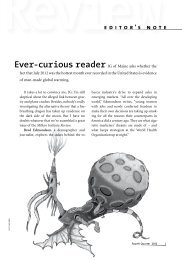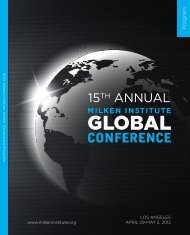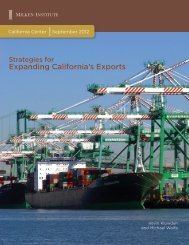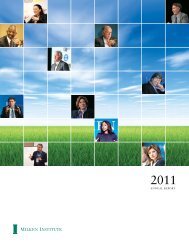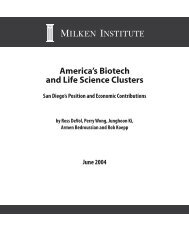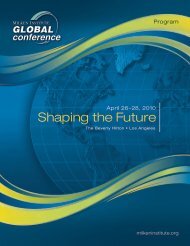The Rise and Fall of the U.S. Mortgage and Credit ... - Milken Institute
The Rise and Fall of the U.S. Mortgage and Credit ... - Milken Institute
The Rise and Fall of the U.S. Mortgage and Credit ... - Milken Institute
Create successful ePaper yourself
Turn your PDF publications into a flip-book with our unique Google optimized e-Paper software.
450<br />
400<br />
350<br />
300<br />
250<br />
200<br />
150<br />
100<br />
50<br />
0<br />
Figure 8: Widening TED spread: Spread between three-month LIBOR <strong>and</strong> T-bill rate<br />
(daily, October 31, 2005–October 31, 2008)<br />
Basis points<br />
500<br />
Historical high before 2008<br />
November 1987: 255 bps<br />
August 20, 2007: 240 bps<br />
August 16, 2007: Countrywide takes<br />
emergency loan <strong>of</strong> $11 billion from<br />
a group <strong>of</strong> banks.<br />
Average since August 2007: 148 bps<br />
12/2005 04/2006 08/2006 12/2006 04/2007 08/2007 12/2007 04/2008 08/2008<br />
13<br />
October 10, 2008: 463.6 bps<br />
September 16, 2008: Fed rescues<br />
AIG for $85 billion.<br />
Average since 1985: 86 bps<br />
Sources: Bloomberg, <strong>Milken</strong> <strong>Institute</strong>.<br />
Note: <strong>The</strong> TED spread is calculated as <strong>the</strong> difference between <strong>the</strong> three-month LIBOR <strong>and</strong> <strong>the</strong> three-month T-bill interest rate.<br />
<strong>The</strong> total amount <strong>of</strong> commercial paper (short-term debt routinely issued by corporations to cover operating expenses)<br />
declined by $366 billion from September 10, 2008, to October 22, 2008. <strong>The</strong> slump fur<strong>the</strong>r demonstrates how <strong>the</strong><br />
subprime mortgage market meltdown had spread throughout <strong>and</strong> beyond <strong>the</strong> financial sector.<br />
Even <strong>the</strong> safety <strong>of</strong> money market funds was called into question. Investors took withdrawals from <strong>the</strong>ir money<br />
market funds from twelve <strong>of</strong> <strong>the</strong> top twenty institutions in <strong>the</strong> four days from September 12 to September 16,<br />
2008. During this five-day period, <strong>the</strong> Reserve Primary Fund suffered massive withdrawals—$24.8 billion, or<br />
nearly half <strong>of</strong> its assets—<strong>and</strong> on September 16 “broke <strong>the</strong> buck,” which means <strong>the</strong> value <strong>of</strong> its shares dropped<br />
below a dollar.<br />
All <strong>of</strong> <strong>the</strong> factors discussed above shook confidence, but <strong>the</strong>re was ano<strong>the</strong>r looming cloud: <strong>the</strong> unregulated market<br />
for credit default swaps (CDS), which had grown enormously in recent years. A CDS is a private contract between<br />
two parties, traded over <strong>the</strong> counter, so no one could say with certainty just how big each firm’s exposure might<br />
be. This murkiness eroded confidence throughout 2008. CDS spreads widened not only for banks, but even more<br />
sharply for <strong>the</strong> travel <strong>and</strong> leisure industry, with automobiles <strong>and</strong> parts industry a close second.





